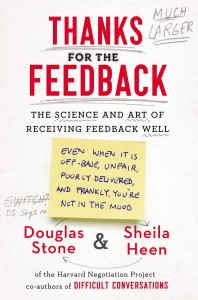 In the business context, giving and receiving feedback is all around us. We’ve participated in feedback sessions, either formal or informal, day-in and day-out since the first day we launched our careers. But being well-versed in the idea of feedback as a form of communication doesn’t mean we all give it or receive it in the same way—or that we’re particularly good at it.
In the business context, giving and receiving feedback is all around us. We’ve participated in feedback sessions, either formal or informal, day-in and day-out since the first day we launched our careers. But being well-versed in the idea of feedback as a form of communication doesn’t mean we all give it or receive it in the same way—or that we’re particularly good at it.
In the legal profession, a better understanding of giving and receiving feedback is critical to your own success, that of your colleagues, your departments, and the professional growth of people you train and manage.
Enter Douglas Stone. He and his co-author, Sheila Heen, recently published “Thanks for the Feedback: The Science and Art of Receiving Feedback Well,” which explores highly useful insights to givers and receivers of feedback—that is, everyone.
In the first of this two-part column series discussing giving and receiving feedback, as detailed in Stone’s book, I will explore feedback from the receiver’s perspective.
According to Stone, receiving feedback sits at the intersection of two basic needs: a drive to learn and a longing for acceptance. And Stone believes the ability to receive feedback well is a skill that can be cultivated, at least in small ways.
The success of giving feedback, Stone and Heen write, has much more to do with the receiver than the giver. Let’s look at an example:
Stephanie, a senior associate, meets separately with two first-year associates to give them feedback on their work. Stephanie says the exact same things to both associates during these feedback sessions.
One young associate, Megan, welcomes the feedback, takes notes, nods and is energized by the information she’s received. She starts thinking about how to immediately apply the constructive criticism in her work.
The other young associate, Betty, hears the same feedback, but receives a different message. She’s discouraged, thinks she isn’t doing very well, assumes her supervisor was disappointed in her work and may not pass equally challenging assignments onto Betty going forward.
Megan and Betty heard the same words for the same work product, however, their responses couldn’t have been more different. That’s because, as individuals, they receive feedback very differently.
Stone points out that, while companies often spend time and resources training feedback givers, little if any is spent on training feedback receivers.
“So we get quarterbacks who are better and better at throwing the ball, but our receivers have little ability to catch the ball,” Stone analogizes in a recent Forbes interview. “Not even Peyton Manning can make the guy on the other end of the pass catch the ball if he’s not interested in catching the ball. Same with feedback. No matter how skilled the feedback giver is, if the receiver isn’t interested in hearing or taking the feedback, nothing will get through.”
According to Stone, the solution lies in training feedback receivers, which he believes should be a top priority for companies. Often, he notes, employees let their own education, advancement and ultimate success ride on the feedback of someone who may or may not be good at delivering it.
“A key insight here is that receiving feedback well is indeed a skill,” Stone says in the Forbes article. “We all show up in life with certain tendencies and competencies, but however good we are at receiving feedback in our default state, we can all get better at it with a bit of training. There are specific teachable skills and tools that make a huge difference.”
Stone says there are four skills receivers can work to improve in an effort to participate productively in feedback conversations:
- Listening. Ask questions, paraphrase the giver’s points, and acknowledge her feelings. Learn to accept that the giver’s view is the giver’s view and learn to listen for what might be valid from the giver’s viewpoint.
- Asserting. This is not arguing. It’s establishing your participation in the conversation. There is a small but critical distinction between “You’re wrong” and “I disagree.”
- Process moves. These are tactics the receiver can use to steer the conversation in a more mutually productive direction.
- Problem solving. It’s more a function of specific skills than innate resourcefulness or creativity. Learn to create possibilities, probe for underlying interests, recognize the crucial difference between interests and positions, and generate an action plan.
Check out “Thank for the Feedback” for more details on these practices and watch for the second Your Career column in this series, which will focus on giving feedback, in June.
